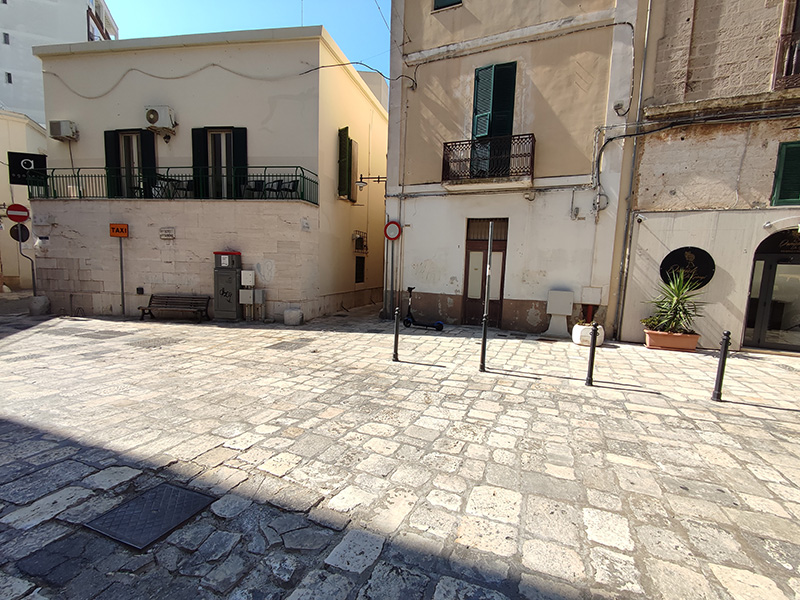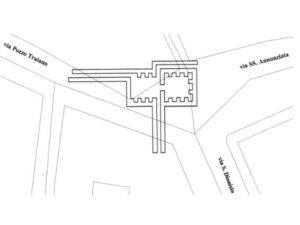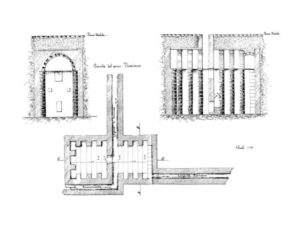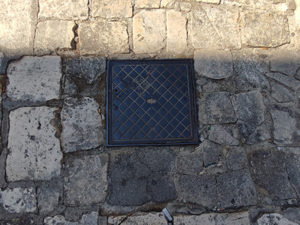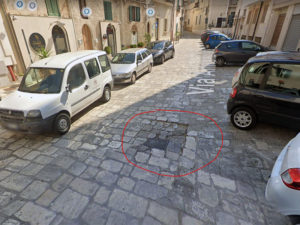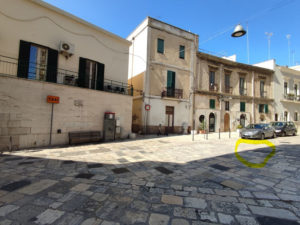La cisterna dell’imperatore
Grande cisterna d’acqua la cui costruzione è attribuita all’imperatore Traiano (Sec. II), ancora esistente al di sotto dell’omonima via.
Camminando per la città mai si potrebbe immaginare che, al di sotto dell’anonimo tombino che c’è tra via Annunziata e via Pozzo Traiano, esiste ancora la grande cisterna d’acqua fatta costruire con tutta probabilità dall’imperatore Traiano, di cui la memoria popolare ci ha trasmesso il toponimo.
Nella sua Brindisi ignorata, Nicola Vacca ci racconta che il Moricino, storico brindisino vissuto a cavallo tra il XVI e il XVII sec., scriveva: “… degli imperatori, solo Traiano fu quello che lasciò qualche memoria di se’ in Brindisi, una fuori la città e l’altra dentro; quella di fuora è la via da lui nominata Traiana, che da Brindisi mena verso Lecce ed Otranto… “.
Poi il Moricino, dopo avere ricordato che Traiano da Brindisi si imbarcò con l’esercito contro Armeni e Parti, dice che probabilmente durante la sua attesa in città fece costruire il pozzo “…che fino al giorno d’oggi somministra copiosissime acque ai Brundusini, che sta sulla medesima strada donde principia a distendersi la suddetta via Traiana…”.
Del resto il castrum urbano Romano era attestato proprio nei pressi, lungo la via Lata (si veda la scheda n. 7, Via Lata) ed è verosimile che l’imperatore Traiano, che fece ammassare l’esercito a Brindisi in vista delle sue Campagne partiche (114 – 117 d.C.), provvedesse all’approvvigionamento idrico delle truppe.
Di fatto il Pozzo Traiano, conosciuto sino alla fine dell’800 come puzzu de la citati (pozzo della città), è alimentato da alcune acque sorgive ed è rimasto in funzione sino al 1928, quando fu rilevato un significativo inquinamento organico delle acque, il cui livello allora si attestava intorno ai 5 metri.
Andrea Della Monica (1674), che ha ripreso i testi del Moricino, lo ricorda caratterizzato da “molti archi magnifici e volte spaziose, d’altezza d’una statura d’huomo”,
mentre il canonico Pasquale Camassa, nel 1910, racconta che la struttura era “formata da due camere separate da un diaframma, con archivolte, voltine e muri d’ambito”.
Ulteriori descrizioni sono riportate in alcuni documenti del 1898 redatti dall’Ispettore degli Scavi e Monumenti di Brindisi Giuseppe Nervegna, dove in un preciso rilievo – una planimetria e due sezioni – inviato al Ministro della Pubblica Istruzione, sono riportati con precisione le caratteristiche strutturali e tecnico-costruttive dell’antica cisterna (fig. 2).
Il serbatoio ha forma rettangolare, di dimensioni 12,20 per 6,40 metri, ed è suddiviso a metà da un muro caratterizzato da quattro aperture di differenti ampiezze ed altezze. All’interno di una delle due vasche venivano convogliate le acque provenienti da tre condotti a sezione rettangolare della larghezza di 70 cm, denominati rispettivamente “Sorgente Annunziata”, “Sorgente Romana” e “Sorgente S. Dionisio”.
Sul sito brindisiweb.it è riportata una scheda particolareggiata della struttura, a cura di Giovanni Membola, studioso contemporaneo di storia locale.
Note bibliografiche:
– Nicola Vacca, Brindisi ignorata, ed. Vecchi & C., Trani (BA), 1954
– Andrea della Monaca, Memoria historica dell’antichissima e fedelissima città di Brindisi, P. Micheli, 1674
– Giovanni Membola, Il Pozzo Traiano, www.brindisiweb.it
The emperor’s cistern
Trajan pit, large water tank built by order of the emperor Trajan (II century). It still exists under the homonymous street
Walking through the city one could not imagine that, under an anonymous manhole cover situated between via Annunziata and via Pozzo Traiano, still exists the biggest tank of water. Likely, it was built by order of emperor Trajan, whose collective memory transmitted us the toponymy.
In his work “Brindisi ignorata” (ignored Brindisi), Nicola Vacca tells that Moricino, historian from Brindisi lived between the XVI and the XVII century, wrote: “… among emperors, only Trajan left some memory of himself in Brindisi, one inside and the other one outside the city. The one outside is the Trajan Street, which goes from Brindisi through to Lecce and Otranto…”. Moricino, remembered that Trajan sailed from Brindisi with his army to face Armenians and Parthians. Then, the historian tells that during his waiting in the city, the emperor ordered the construction of the well “… which, until today, provides Brindisi people with water, and which is located on the same street where the Trajan Street starts…”
In fact, the Roman urban castrum was situated nearby, in via Lata. It is likely that the emperor Trajan provided water to his troops, massed in Brindisi due to Parthians military campaigns (114 – 117 d.C.).
Indeed, the Trajan pit, also known until the end of the XIX century as “town’s pit”, is feed by spring water. It remained in operation until 1928, when significant organic pollution was detected in its waters, which level was then around 5 mt.
Andrea Della Monica (1674), on the basis of Moricino’s texts, remember that the well was characterized by “numerous magnificent arches and wide vaulted ceilings, which size was that of the height of a man”. On the other hand, canon Pasquale Camassa tells, in 1910, that the structure “consisted of two rooms separated by a diaphragm, with big and small vaulted ceilings and shear walls”. Other descriptions are reported in some documents from 1898, written by the Excavation and Monuments Inspector Giuseppe Nervegna. He sent to the Ministry of the Public Instruction a survey – a planimetry and two sections – where are accurately shown structural and technical-construction features of the ancient cistern.
The tank has rectangular shape and a size of 12,20 x 6,40 mt. It is divided into parts by a wall, which has four windows with different size. The water came from three rectangular channels with a width of 70 cm, called, respectively, “Annunziata source”, “Roman Source” and “S. Dionisio source”. Then, the water was channelled inside one of the two basins.
On the brindisiweb.it website is possible to find a detailed sheet of the structure, edited by Giovanni Membola, contemporary scholar of local history.
Bibliographic notes:
– Nicola Vacca, Brindisi ignorata, ed. Vecchi & C., Trani (BA), 1954
– Andrea della Monaca, Memoria historica dell’antichissima e fedelissima città di Brindisi, P. Micheli, 1674
– Giovanni Membola, Il Pozzo Traiano, www.brindisiweb.it

